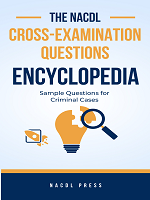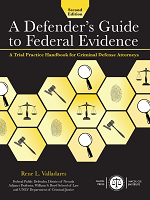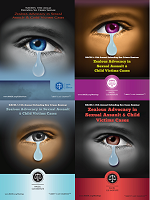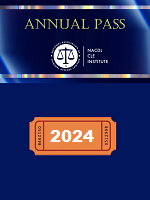Access to The Champion archive is one of many exclusive member benefits. It’s normally restricted to just NACDL members. However, this content, and others like it, is available to everyone in order to educate the public on why criminal justice reform is a necessity.
“The Life of Riley” could be, at least initially, mistaken for any number of American cultural concepts from a popular American radio show to a feature film, to a comic book — all dating to the 1940s and 1950s. It also could be interpreted as a reference to the phrase “living the life of Riley,” another American iconic phrase generally meaning living an ideally carefree and contented life — apparently not as negative as “freeloading or gold digging” but rather implies “someone is kept or advantaged”1 — at least if you buy into the easily accessible, Google-infused immediate Internet Wikipedia-delivered definition of the day.
And for anyone unaware of the meaning of these phrases, all it takes is an inquisitive mind and a quick press of a fingertip on a mobile device or computer keyboard to reveal the answer. Electronic answers — so instantaneous, so comprehensive, and so limitless — are always available via that gentle press of a fingertip. What if that fingertip is attached to an unwelcome hand? What if a law enforcement agent’s fingertip is tapping on a screen in order to obtain an individual’s personal information — so extensive, so limitless — without obtaining a search warrant?
Instantaneous electronic answers can reveal information that is so private and far-reaching that no one, and certainly not the government, should have access without the time-honored and constitutionally required search warrant issued upon oath and affirmation, based upon probable cause and issued by neutral and detached issuing authority. That is what we know as a result of the U.S. Supreme Court’s decision in Riley v. California.2 I hope this decision begins “the life of Riley.” Riley recognizes and honors the Fourth Amendment and privacy. Ironically, our jurisprudential search and seizure history has turned “exceptions” to the search warrant requirement into the rule. The Court’s language was clear and concise: “Our answer to the question of what police must do before searching a cellphone seized incident to an arrest is accordingly simple — get a warrant.”3
The decision in Riley was a perfect example of events often overshadowing plans. No longer could I write my first intended introductory message as president, as Riley (1) was a profoundly important decision for the country, (2) its future potential use was intriguing and promising, and (3) it also reminded me of my beginnings with and relationship to NACDL.
To start, I had the benefit of hearing Jeff Fisher, counsel to Riley, discuss his case, pre-decision, in January at NACDL’s Advanced Criminal Law Seminar. I invited him4 to speak at NACDL’s Annual Meeting in Philadelphia. Second, it felt like “déjà vu all over again.” More than 20 years ago, I represented the ACLU in another search and seizure case, Commonwealth v. Edmunds.5 I thought “everything was at stake” as the Pennsylvania Supreme Court considered whether to adopt SCOTUS’s “good faith” exception to the probable cause requirement espoused in United States v. Leon.6 Fortunately, in a landmark decision the court squarely rejected Leon on independent and adequate state constitutional grounds. The Edmunds case resulted in my greater involvement with NACDL. I had been a member since 1979 but with that opinion, then-President Jeff Weiner asked me to co-chair the State Constitutional Rights Committee. Thus began my wholly unexpected and unintended transformation from NACDL member to a more fully engaged member. As I look back, I could not be more thankful or grateful to have met so many wonderful people and had the opportunity to participate in so many of NACDL’s great works.
Will Riley give birth to more favorable decisions? What arguments must we now make, litigate, and preserve? What arguments can now be advanced — either to ultimately succeed, or if not, at least to drive a better resolution, plea agreement, or sentence?
And now to the “life of Riley.”
As food for thought, consider the following:
- Is United States v. Miller7 (holding that banking records may be seized without a warrant and without probable cause) safe from attack and reversal? Ask not what personal information is found within a smartphone. Ask what personal information can be learned about an individual’s background, history, whereabouts, relationships, and interests from a review of banking records.8
- Is Smith v. Maryland9 (permitting warrantless tracing of phone calls) affixed with a yellow warning sign now that Riley has risen?
- Are searches of laptop, desktop, and other computers in need of greater directives and limitations that clearly — and with specificity — constrain searches and seizures only to those files in which probable cause exists so as to avoid ‘general searches” and wholly unjustified invasions of privacy?
- Do we need to take a closer look at cloud storage, remote computing, and GPS tracking?
- In this digital age during the burgeoning life of Riley, should older and entrenched court decisions be re-examined before being deemed controlling case law in cases involving the use of new technology?
- While Riley concluded cellphones and smartphones are different, could the underpinnings and privacy concerns of Riley generate greater protective First and Fifth Amendment jurisprudence?
- Is statutory use immunity still a court-determined satisfactory co-extensive equivalent protection and an adequate answer to the rightful invocation of the Fifth Amendment?10 Is it still a constitutionally permissible governmental permissive alternative, or is the revelation of such personal information maintained by the person just too private and too extensive that it should not be forced to be revealed?
- Should a partnership or closely held corporation be entitled to take the Fifth? Reinvigorating Boyd and re-evaluating other historic cases such as Bellis,11Hale v. Henkel,12 and White13 may be a lot to ask but then again the personal information contained in those records is perhaps just too massive and too private. Perhaps the opportunity to overcome the difficulty of asserting a personal constitutional right when it is “shared by others” is ripe for reconsideration.
Riley rejected theoretical claims of “emergency” or “exigent circumstances” while leaving open the possibility when proven facts exist. The Court recognized that privacy comes at a cost. Fortunately, the justices decided to purchase privacy rather than favor law enforcement. What a breath of fresh air! Nowhere does the opinion offer an apology for the favorable defense application of Fourth Amendment jurisprudence. Instead, it presents a clear and bold recognition: “We cannot deny that our decision today will have an impact on the ability of law enforcement to combat crime.”14
Further, NACDL has made its voice heard on the issue of digital searches. In May 2014, the board of directors adopted a report on law enforcement searches of digital evidence. The report makes nine recommendations for reform.15
I hope when you think of California v. Riley, you also will think of “The Life of Riley” and how you can help to make it an enduring American concept, certainly worth being “kept or advantaged.” Let’s hope that — with your work and that of NACDL — it turns into a legacy with a multitude of progeny.
I enjoyed seeing so many of you in Philadelphia at the Foundation for Criminal Justice Gala and at our Annual Meeting. I hope that you feel it succeeded, as intended, in providing an opportunity for each of you to spend meaningful and memorable time with your friends and colleagues.
I am reminded every day that it is indeed an honor to serve as the president of an organization whose members are “liberty’s last champions.”
NACDL, Amen.
Notes
- Wikipedia, http://en.wikipedia.org/ wiki/The_Life_of_Riley (last visited Sept. 24, 2014).
- Riley v. California (and companion case United States v. Wurie), 134 S. Ct. 2473 (2014) (The Court held that law enforcement officers cannot search cellphones incident to arrest without a warrant. A smartphone was involved in the Riley case; police seized a flip phone in Wurie.).
- Id. at 2495.
- I also invited his exceptional fellow panelists, Neal Katyal, former Acting Solicitor General of the United States, and Jeffrey Rosen, CEO of the National Constitution Center.
- Commonwealth v. Edmunds, 526 Pa. 374, 586 A.2d 887 (1991).
- United States v. Leon, 468 U.S. 897, 82 L. Ed. 2d 677 (1984).
- United States v. Miller, 425 U.S. 435 (1976).
- Jon May, Is the Supreme Court Ready to Re-examine U.S. v. Miller? White Collar Crime Blog (July 4, 2014), http://lawprofessors.typepad.com/whitecollarcrime_blog.
- Smith v. Maryland, 442 U.S. 735 (1979).
- Kastigar v. United States, 408 U.S. 931 (1972).
- Bellis v. United States, 417 U.S. 85 (1974) (Fifth Amendment privilege does not apply to production of partnership records but noting it did not address “a small family partnership” or “where there was some other pre-existing relationship of confidentiality among the partners.” Id. at 101). But see the dissent by Justice Douglas.In Fisher v. United States (1976), the Supreme Court stated: The proposition that the Fifth Amendment prevents compelled production of documents over objection that such production might incriminate stems from Boyd v. United States, 116 U.S. 616 (1886). … Among its several pronouncements, Boyd was understood to declare that the seizure, under warrant or otherwise, of any purely evidentiary materials violated the Fourth Amendment and that the Fifth Amendment rendered these seized materials inadmissible. … Several of Boyd’s express or implicit declarations have not stood the test of time. The application of the Fourth Amendment to subpoenas was limited by Hale v. Henkel, 201 U.S. 43 (1906).
- Hale v. Henkel, 201 U.S. 43 (1906), one of the first cases to hold that certain types of organizations cannot assert the Fifth Amendment. But see the dissenting opinion.
- United States v. White, 322 U.S. 694 (1944) involved a subpoena to the officer of a labor union. The Court did not extend the Fifth Amendment to the labor union, holding in part that the organization was impersonal and therefore White could not hold the records personally.
- Riley, 134 S. Ct. at 2493.
- The report, What’s Old Is New Again: Retaining Fourth Amendment Protections in Warranted Digital Searches, is available at http://www.nacdl.org/reports.






